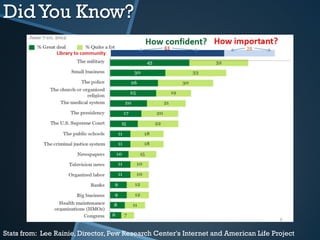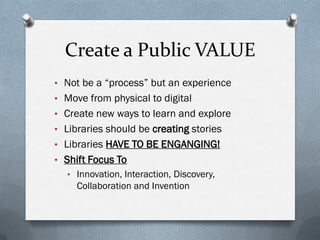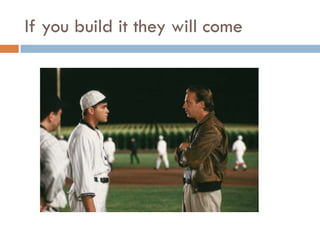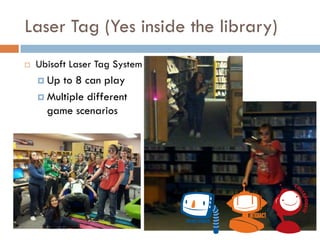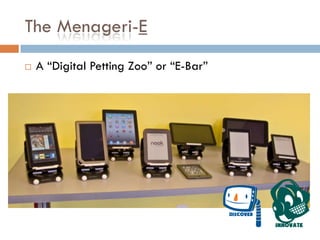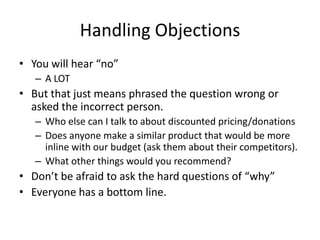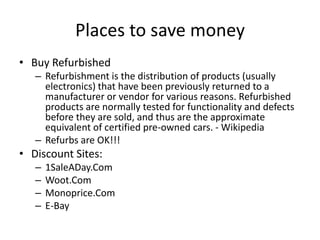Designing Interactive Library Spaces - Seminar w/ EdLab, Teachers College of Columbia University
- 7. DidYou Know? Stats from: Lee Rainie, Director, Pew Research Center's Internet and American Life Project
- 8. DidYou Know? Stats from: Lee Rainie, Director, Pew Research Center's Internet and American Life Project
- 9. DidYou Know? Stats from: Lee Rainie, Director, Pew Research Center's Internet and American Life Project
- 10. Create a Public VALUE • Not be a “process” but an experience • Move from physical to digital • Create new ways to learn and explore • Libraries should be creating stories • Libraries HAVE TO BE ENGANGING! • Shift Focus To • Innovation, Interaction, Discovery, Collaboration and Invention
- 12. What Does A Community Ask For? O Study Rooms / Homework Area O Open Areas O Tech (Computers) O Business Centers O MakerSpaces O ?Others? What do these things have in common?
- 13. Libraries need to find ways to engage their patrons
- 14. Libraries and Learning Spaces Have To Be Engaging O Encourage Creativity and Invention O Allow Discovery O Increase Collaboration O Generate Interaction O Foster Innovation
- 20. Evolve: A Library Playground O Fab Lab / “Hackerspace” / “MakerSpace O A location where people with common interests (usually in computers, technology, science, or digital or electronic art) meet, socialize and/or collaborate. O Can be viewed as open community labs incorporating elements of workshops and/or studios where people can come together to share resources and knowledge to build and make things and ideas. O Combining the positive & fun aspects of schools, museums, and playgrounds into one “entity”.
- 21. Take Risks
- 22. We All Have Creative Potential
- 23. Collaborative Areas (Either Network Based or In A Room) Provide Tools (Hardware and/or Software) Learning Labs or Training Centers Types of Learning Spaces
- 26. Music / Graphic Design / Video Editing
- 27. 3D Printing
- 28. Allen County Public Library
- 29. Multimedia Room / Learning Centers Room Set Up Features: Clickers Allows for jeopardy style gaming Smart Board (interactive white board) Full DVD/BluRay/Sound System Easy to use and start (Touch Panel System) You Can Use This Room For Jeopardy Movie Nights Presentations / Interactive Style Board Game Night Create a Business Plan, Project Plan, etc
- 31. The 4th floor is a public laboratory and educational facility with a focus on information, design, technology, and the applied arts. The 14,000 sq foot space hosts equipment, expertise, programs, events, and meetings that work within this scope. While traditional library spaces support the consumption of knowledge by offering access to media, the 4th floor is unique because it supports the production, connection, and sharing of knowledge by offering access to tools and instruction. Chattanooga ”Fourth Floor”
- 33. If you build it they will come
- 34. Designing Interactive Learning Space
- 35. Key Design Concepts Adding Color Art Have Open Areas Furniture Modularity Technology
- 36. Adding Color White = Boring Think about Parks (typically colorful) Painting walls is an inexpensive redesign Use Fun Colors Be Bold! Children Areas should use bright attractive areas.
- 38. Art Have patrons/users create the art Donate it to the space Mix it up as often as you like. There is no cost.
- 39. Open Areas Open Space! Seating Tables Multi Functional Areas Less Closed Rooms Activity Rooms, Meeting Rooms, etc
- 44. Modularity Allows the environment to change easily Let your users define the space Put things on wheels Desks …No Need For Shelves To Be On Wheels Don’t fasten furniture to floor… no one will be stealing a desk
- 45. Fill The Space With Fun Interactive Technology Allow People to CHECK THINGS out INTERACTIVE TECHNOLOGY
- 46. Play Time
- 47. Kurio Tablet Cheap Tablet Locked Down Secure
- 48. Little Bits littleBits is an open source library of electronic modules that snap together with tiny magnets for prototyping, learning, and fun.
- 49. Meet Sphero.
- 50. Creation Station – Sifteo Cubes Small LCD screens that can sense when there are nearby cubes and react accordingly
- 51. Creation Station – Lego We-Do Robotic Legos that move; teaches how to program through a GUI interface
- 52. Smart Tables Interactive Touch Table Top Easy to load and install games Up to 8 children can play, 100 finger touches
- 54. Laser Tag (Yes inside the library) Ubisoft Laser Tag System Up to 8 can play Multiple different game scenarios
- 56. The Menageri-E A “Digital Petting Zoo” or “E-Bar”
- 57. Music Station
- 58. Children’s Collection Rotating Collection Provides an “always new” environment Child Friendly Shelves Bin style shelving, so children can “flip” through books Bright, Fun, Attractive Colors.
- 59. See a virtual tour at http://tinyurl.com/Evolve-VirtualTour
- 60. Your environment can have all the best tech toys and cool fablabs but it could still fall short. It is up to the frontline staff to ENANGE their audiences. A friendly hello goes a long way. Allow the staff to play with the tech; get them involved to reflect that excitement to the users.
- 61. • Use the tools your users use • Communicate on their level • These are your #1 Marketing Tools
- 62. Digital Content Curation Encourage creativity
- 63. Film A Zombie Movie (Cameras and some Face Paint for Your Library)
- 64. Link Books to E-Books Find New Content Scavenger Hunts
- 65. Open a new dimension in your library. Buy using an app, you can see a new “world” within your physical space.
- 66. Place books into color themed bags. Barcode number written outside of bag. Allow patrons to check out and take them home.
- 67. During special holiday periods, find books that are colored the holiday colors (not necessarily about the holiday) and place them on a stand near your end caps.
- 68. Purchase Cheap Plastic and Foam to setup Paths and fairways with felt. Have it throughout the library, engage the participants through your space.
- 71. • Put a “Reward System” into the library card • Badges • Prizes • Exclusive Programming / Event registration • Low Tech: • Print new more colorful library cards, allow patrons to customize their card with different and increasingly more desired badges – based off books read, programs attended, etc. • High Tech: • Create Library Cards with screens • Send Messages to card when they are in the library (wirelessly connected) • Display “reading level” or “badges they own”
- 74. • The Game of Books is gamifying the reading experience. • In the Game, you are the character that you are leveling up; books are the magical items that give you rewards. • This is a project from BookLamp.Org • Each Book in the world has a very specific DNA, a structure that contains specific themes, writing style, density, etc. • The themes in the book relate to points – and those points apply to your character. • More Details: www.gameofbooks.com
- 77. Technology As An Evolution O 1990 – 2000: Internet Burst O 2000 – 2010: Value Adds to Technology O 2010 – 2020: Technology Burst
- 78. Future of Technology O To discover and curate of information O Value adds (efficiency, reliability) O To build or discover new “things”
- 80. General Themes O Touch-Based O Gesture-Based O Object Orientated O Mobility/Connectivity O Open Source Hardware
- 81. Touch Based O People want to touch everything O Discover Through Touch O Search Through Touch O Learn Through Touch
- 88. Gesture Based O Communicate with Technology Hands Free O Uses multiple cameras to detect depth/movement O Microsoft Kinect O Sites to Explore: O Microsoft Kinect O PrimeSense O Evoluce
- 95. Object Orientated O Use Objects to interact with surfaces
- 100. Back To Searching O Technology is becoming more “visual” orientated O Whether it be from touch, gesture, or objects O Search Dynamics are changing
- 101. What’s this talk about “Big Data” O Technology is being used to identify trends in our lives. This data is being curated and collected. O This can help us with: O Identifying health trends O Saving Time or Energy O Increase efficiency in our lives
- 102. Memoto – Life Logging Camera
- 103. Waze – Crowd-Sourced Traffic Data
- 105. Goji Smart Lock
- 106. FitBit Tracks What You Do
- 107. Future Concepts O People watching TV can point and click to buy content (clothes, cars, etc) O Predictive searches (Amazon does it now) O Ask yourself, what do you want to create?
- 108. There never seems to be enough money to do anything
- 109. So Where Can Money Come From?
- 110. Crowd-Source Funding • People across the world group together to fund new projects and ideas • People are encouraged to donate by either the attractive name or “awards” based off the amount they donate. • Kickstarter.com • Indiegogo.com
- 114. Social Media • Market your “Brand” heavy through social media – And Blogging • Solid companies pro-actively manage their social media accounts. – They watch what people are saying because everyone else can see what people say – They want only positivity about their company on the web, they will work to only have positive comments. – If a company does provide assistance, always show your support through social media • (you may need more support later on down the road). Social Media is a way to develop relationships
- 116. Tips - Twitter • Only use positivity when communicating on twitter • 140 Characters, make them count! – Wow! @COMPANYX has some really great stuff. I need to get my hands on it – Who would like to see @PRODUCT in our library space? • Once you build a good relationship ask the hard questions – Can you help me on the cost @COMPANYZ
- 117. Tips - Facebook • Go to the Company’s Pages, be sure to “Like” their page before commenting • Again, be only positive. Tell your story, pitch your idea.
- 119. Handling Objections • You will hear “no” – A LOT • But that just means phrased the question wrong or asked the incorrect person. – Who else can I talk to about discounted pricing/donations – Does anyone make a similar product that would be more inline with our budget (ask them about their competitors). – What other things would you recommend? • Don’t be afraid to ask the hard questions of “why” • Everyone has a bottom line.
- 120. Just Ask
- 121. Places to save money • Buy Refurbished – Refurbishment is the distribution of products (usually electronics) that have been previously returned to a manufacturer or vendor for various reasons. Refurbished products are normally tested for functionality and defects before they are sold, and thus are the approximate equivalent of certified pre-owned cars. - Wikipedia – Refurbs are OK!!! • Discount Sites: – 1SaleADay.Com – Woot.Com – Monoprice.Com – E-Bay
Editor's Notes
- Allow your patrons the ability to build things. Fab Labs/Maker Spaces
- With the idea of an open play environment; people will discover new and exciting things on their own.Fact: You remember things that you discover on your own better than things told directly.
- Collaboration allows people to get together to discuss common interests to gain new knowledge. People will collaborate naturally if centered around something FUN!
- Interaction will allow your patrons to learn and grow.Interaction is necessary to maintain interest in your library’s programs, collection, etc.
- Innovation must be an original disruptive act.Innovation is the embodiment, combination, and/or synthesis of knowledge in novel, relevant, valued new products, processes, or services
- Ways to Engage Your Space (MiniGolf, QR Codes, Color Bags)
- Purchase different colored paper bags o Each bag is for a different genre of book o Place Barcode number outside of bag May have to write it o Place book inside bag, and staple it close Gets your circ numbers up!
- Christmas – take red and green books and them facing outside the shelves. The colors of the covers/spines will brighten up your collection






